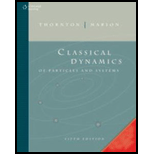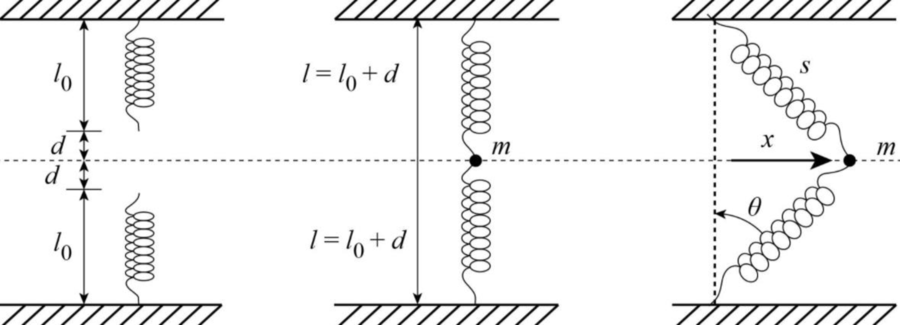
The potential corresponding to the motion of particle.
Answer to Problem 4.1P
The potential corresponding to the motion of particle is
Explanation of Solution
Consider the figure below.

Unstretched length is
Here, F is the force on the mass.
Potential is given by,
Here, U is the potential.
From the diagram,
The unstretched length is given by,
Replace
Using Binomial theorem and expressing up to first two terms,
Conclusion:
Substitute for F in the expression for U and integrating,
Therefore, potential corresponding to the motion of particle is
Want to see more full solutions like this?
Chapter 4 Solutions
Classical Dynamics Of Particles And Systems
- Consider a particle moving in the region x > 0 under the influence of the potential where U0 = 1 J and α = 2 m. Plot the potential, find the equilibrium points, and determine whether they are maxima or minima.arrow_forwardA mysterious force acts on all particles along a particular line and always points towards a particular point P on the line. The magnitude of the force on a particle increases as the cube of the distance from that point; that is Fr3 , if the distance from P to the position of the particle is r. Let b be the proportionality constant, and write the magnitude of the force as F=br3. Find the potential energy of a particle subjected to this force when the particle is at a distance D from P, assuming the potential energy to be zero when the particle is at P.arrow_forwardA particle moves in a force field described by the Yukowa potential V (r) = −k/r exp(−r/a) where k and a are positive. Show that if the orbit is nearly circular, the apsides will advance approximately by πρ/a per revolution, where ρ is the radius of the circular orbit.arrow_forward
- 3:30 A docs.google.com If the speed at x = 1, v(r = 1) = 3 m/s then the speed at x = 0, v(x=0) is: Can't be determined Option 4 v = 0 Option 3 v = V = /23arrow_forwarda particle is moving under the potential V(x)=cx³-dx². Here c and d are constants. The particle is at rest initially and is at stable point. Calculate the minimum speed of the particle when it reached to unstable point.arrow_forwardProblem #2: Find the work done by the following force field F(x, y) = 4(y + 6)7 i + 28x (y + 6)6 j in moving an object from P(6, -6) to Q(4,-4), along any path. Problem #2:arrow_forward
- Problem 6. Assume that a force field f is given in the (r, y)-plane, and consider a mass m is moving under the influence of f. The total energy of the mass is defined by the following expression E=m lu?+V(z, y), where v= is the velocity vector of the mass along the curve y= (#(t), y(t)), and V is the potential of the mass defined by the relation f=-vV, where V is the gradient operator defined as VV = Ae dE du Show that dt =0 assuming the NEWTON's second law m=f, and conclude that the mass moves along dt the solution to the following differential equation dr+ dy-0.arrow_forwardA test point-like particle moves in the gravitational potential = - C/r, where C is a positive constant and r = - √x² + y² + z² is the radial distance from the centre of space. Initially the particle has a velocity vo pointing outwards in the radial direction and is at distance from the centre. What is the minimal value of the speed vo= |vo| for which the particle never falls back to its original position: Select one: O a. vo v /2C/ro O b. It cannot be calculated since we do not know the mass of the test particle O c. Vo = 2Cro O d. vo 2C/roarrow_forwardConfirm that the force field F (x, y) = 2xy°i + 3x?y?j is conservative in some open connected region containing the points P(-9,4) and Q(6,1), and then find the work done by the force field on a particle moving along an arbitrary smooth curve in the region from P to Q. NOTE: Enter the eract answer. W =arrow_forward
- A body with mass 0.40 kg moves in one dimension according to a potential of theform U(x) = A/x3-B/x , where A = 4.0 Jm3 abd B = 3.0 Jm, and we take x > 0. (a) Sketch the form of the potential.(b) Find the force F resulting from this potential as a function of position x.(c) Find the equilibrium position(s) and determine whether they are stable or unstable.(d) If the speed of the body at x = 4.0m is v = 3.9 ms−1, what is the speed atx = 1.5 m?(e) Explain briefly what type(s) of motion are possible in this potential if the totalenergy E = 3.0 Jarrow_forwardASSIGNMENT: (0,1,1) Problem 1 Given the force field F= 2yi + 2x) + 2zk, (-1,0,0) find a scalar potential o such that F= Vo; () use the potential p to find the work W done by force F in moving from point (-1,0,0) to (0,1,1).arrow_forwardA particle of mass m moves in one-dimensional motion through a field for which the potential energy of the particle–field system is U(x) = (A)/(x3) - (B)/(x)where A and B are constants. The general shape of this function is shown. (a) Find the equilibrium position x0 of the particle in terms of m, A, and B. (b) Determine the depth U0 of this potential well. (c) In moving along the x axis, what maximum force toward the negative x direction does the particle experience?arrow_forward
 Classical Dynamics of Particles and SystemsPhysicsISBN:9780534408961Author:Stephen T. Thornton, Jerry B. MarionPublisher:Cengage Learning
Classical Dynamics of Particles and SystemsPhysicsISBN:9780534408961Author:Stephen T. Thornton, Jerry B. MarionPublisher:Cengage Learning University Physics Volume 1PhysicsISBN:9781938168277Author:William Moebs, Samuel J. Ling, Jeff SannyPublisher:OpenStax - Rice University
University Physics Volume 1PhysicsISBN:9781938168277Author:William Moebs, Samuel J. Ling, Jeff SannyPublisher:OpenStax - Rice University

